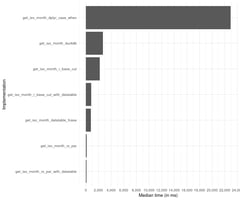In this series of articles, we explore the significant role of advanced analytics within the...
Part 1: Advanced Data Analytics in Consumer Packaged Goods Companies
In the ever-evolving Consumer Packaged Goods (CPG) sector, data and analytics (D&A) stands as a pivotal force for companies aiming to remain competitive and innovative. In this series' first article, we'll explore the outsized role of advanced analytics and its transformative use cases within the CPG industry.
The consumer-goods industry has traditionally adopted a cautious stance toward digital innovation, ranking low among industries for digital uptake according to McKinsey's Digital Quotient analysis1. Harvard Business School's analysis of 150 companies across various sectors similarly revealed that Consumer Packaged Goods companies are generally at the beginning of their digital transformation journey.2
However, when it comes to analytics maturity, the industry has sized on the opportunity and fares much better, being placed in the top five. This makes sense, as consumer-goods companies typically concentrate on well-established analytical practices such as pricing, which don't rely heavily on direct consumer data. In contrast, sectors like banking and retail, which have a direct line to consumers, invest more in digital capabilities to innovate in business models or create a seamless omnichannel experiences.
The 'Why' of Advanced Analytics in CPG
In an industry that lacks the direct transactional data insight that sectors like finance and retail enjoy, CPG companies have turned to advanced analytics to dynamically understand their market and consumers. Advanced analytics steps in to bridge this knowledge gap by drawing on diverse data sources to provide a composite view of consumer behavior and market trends.
The ability to swiftly adapt to changes in consumer needs and expectations is another compelling reason why CPG companies are turning to D&A. With the rise of digital channels and shifting consumer preferences, analytics provides the agility to respond to these changes effectively and in real-time.
This industry features a very high "transactional intensity" across its operating model, from production to sales to distribution. Saving even fractions of a cent on costs, optimizing prices, or streamlining logistics—when multiplied by millions or billions of instances—can accumulate and have a significant impact. This creates a prolific environment for data-driven insights that lead to decisions and actions at scale.
Market segmentation has become more nuanced, calling for an analytical approach that can only be sustained by deep data insights. Data Science allows CPG firms to dissect the market into ever more granular pockets instead of traditional segments, enabling the development of brands, products and go-to-market strategies with unprecedented specificity, focus and speed.
Personalization has transcended being a mere marketing buzzword to become a strategic and profit-driving imperative. Advanced data analytics empowers CPG companies to personalize at scale, creating targeted products and campaigns that resonate with both individual consumers and channel partners, igniting organic demand and shifting away from expensive short-term transaction focused initiatives.
In the long term, the strategic and methodical use of data analytics underpins steady growth and innovation. By providing insights into consumer demands and efficient resource utilization, analytics helps CPG companies innovate systematically and profitably.
Significant Use Cases in CPG
The applications of advanced analytics are vast and varied, impacting several core processes and practices.
Integrated Business Planning (IBP)
Beyond being a routine process, IBP, an expansive evolution of Sales and Operations Planning (S&OP), has become a structural component of data and analytics-driven planning and execution. By integrating historical and market data, forecasts, financial targets, and operational plans in multiple what-if scenarios, IBP platforms fed with carefully curated and processed data, enable companies to anticipate market shifts and manage resources proficiently.
Usually a well-oiled machine, integrated business planning has paved the way for advancements in descriptive and predictive analytics, seeding a culture of data-driven leadership, collaboration and decision making. Holistically implemented, it's a horizontal process and distributed platform enabled by data, engineering and talent capabilities ripe for leveraging to inspire, accelerate and connect other data-centric projects.
Portfolio Planning
Analytics shines a light on consumer trends, helping companies to manage their product portfolios based on richer insights. It identifies which products to innovate, which to sunset, and which new markets to enter, ensuring relevance and profitability.
Revenue Growth Management (RGM)
RGM, as an advanced analytics solution, consists of interrelated components that include pricing, promotions, assortment, and trade investment. It's essential to develop these elements both individually and collectively within a project portfolio, as we'll discuss in the forthcoming article on best practices. Advanced analytics can refine these practices from guesswork to precision with data science. Yet, their interconnected nature demands an integrated approach for optimal impact on demand shaping.
.jpeg?width=623&height=261&name=Blog%20(1).jpeg)
Precision Pricing
In a fiercely competitive landscape, advanced analytics provide a fact-based baseline for pricing strategies, enabling CPG companies to navigate the complex interplay between consumer demand, competitor pricing, and market conditions, leading to optimized margins and sales volume.
Precision pricing, directly impacting profits, allows CPG companies to sell the right product, to the right customer, at the right time, and crucially, at the right price, leveraging data-driven insights to efficiently align the interests of consumers, retail channels, and the company itself.
Promotional Effectiveness
McKinsey, a renowned global consultancy, reports that companies in the consumer-packaged goods sector allocate roughly 20% of their annual revenue to trade promotions. Despite this significant investment, over half experience a loss on these activities. In stark contrast, the most effective promotions among these companies generate a return that quintuples that of their least effective counterparts.3
Advanced analytics has evolved to a point where it enables CPG leaders to understand market dynamics more predictably and refine shopper and channel segmentation. This enhanced granularity not only boosts returns on promotional investments but also allows these investments to be more strategically and precisely aligned with targeted business initiatives.
Assortment Optimization
Retail shelves aren't infinite, and analytics helps decide what sits on them. By predicting which products consumers will gravitate towards, analytics ensures a mix that activates customers and drives sales.
Channel Optimization
Advanced analytics enhances channel optimization by utilizing data-driven insights to evaluate channel performance, consumer preferences, and purchasing patterns. This enables marketers to strategically allocate resources, personalize marketing efforts, and efficiently distribute products across the most profitable channels, maximizing both reach and revenue.
Suggestions and Recommendation
Suggested orders and product recommendations, derived from applying data science to transactional and complementary data, stimulate brands and products in the appropriate channels, locations, and the consumers they serve. This precision enhances individual location performance, boosts face-to-face sales effectiveness, and improves both transaction value and customer experience in self-service e-commerce.
As the last mile in the revenue growth management process, these tools start with basic functionality to empower sales agents or ease the transition to self-service ecommerce platforms, eventually evolving into a crucial component of a comprehensive revenue shaping strategy.
Commercial Execution
Advanced strategies in assortment, pricing, promotions, and trade investments must be deployed at scale across calendars, retail channels, and both face-to-face and digital touchpoints, presenting a significant implementation challenge.
Analytics tools can orchestrate and focus marketing, field sales, and e-commerce processes, improving effectiveness by prioritizing and targeting activities, tracking and measuring execution effectiveness, and aiding sales managers in optimizing frontline attention and productivity.
Supply Chain Transparency
Analytics brings clarity to the supply chain, from sourcing to shelf. It predicts the risk of disruptions, optimizes routes, and ensures that companies can deliver on the promise of right product, right place, right time.
Production Efficiency
At the heart of CPG, production can either be a cost sink or a value creator. Analytics optimizes production lines, ensuring minimal waste, optimal output, and agile responses to changing consumer demands.
Next in the series
The use of advanced analytics in the consumer-goods sector is not just about adopting new technologies; it's about ingraining data into the DNA of business processes to steer companies toward a future of growth, resilience, and adaptability.
Digital and analytics programs have become essential; without them, companies struggle to compete in modern business ecosystems. Developing structural data science, engineering and deployment capabilities is critical for using these tools effectively across an entire organization, thereby ensuring a sustainable competitive edge.
In the next installment, we will explore best practices for overcoming these challenges and the potential financial impacts of this analytical transformation.
References
1. Solving the digital and analytics scale-up challenge in consumer goods, McKinsey & Co., March 2020
2. Democratizing transformation, Harvard Business Review, May-June 2022
3. How analytics can drive growth in consumer-packaged-goods trade promotions, McKinsey & Co., October 2019

.png?height=200&name=blog%20banner%20(2).png)


